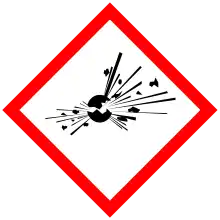| Names | |
|---|---|
| Systematic IUPAC name
Manganese(II) dichlorate[1] | |
Other names
| |
| Identifiers | |
3D model (JSmol) |
|
| ChemSpider |
|
PubChem CID |
|
| |
| |
| Properties | |
| Mn(ClO3)2 | |
| Appearance | Viscous pink liquid |
| Melting point | −18 °C (0 °F; 255 K) |
| Boiling point | 6 °C (43 °F; 279 K) (decomposes) |
| Soluble | |
| Hazards | |
| GHS labelling: | |
 | |
| Related compounds | |
Other anions |
Manganese(II) perchlorate |
Other cations |
Copper(II) chlorate |
Except where otherwise noted, data are given for materials in their standard state (at 25 °C [77 °F], 100 kPa).
Infobox references | |
Manganese(II) chlorate is an unstable chemical compound with the formula Mn(ClO3)2. It is unstable even in dilute solution. As a hexahydrate, it is solid below −18°C. Above this it melts, to form an extremely explosive pink liquid.[2]
Preparation
Manganese(II) chlorate was produced by the reaction of manganese(II) sulfate and barium chlorate.[3] The water was removed by boiling in vacuum. Then the temperature was lowered to -80°C which resulted in a pink solid. Then it was cleaned with liquid nitrogen and potassium hydroxide to remove the decomposition products.[2]
Properties
Manganese(II) chlorate forms the hexahydrate when solid, the water that cannot be removed. It decomposes above 6°C, to manganese(IV) oxide, chlorine dioxide, and water. In liquid form it is very viscous and extremely explosive. When heated to room temperature, it explodes with a sharp report.[2]
References
- ↑ "Manganese(2+) chlorate hydrate (1:2:6)". ChemSpider. ChemSpider. Retrieved 23 August 2021.
- 1 2 3 Brown, F. E.; Woods, J. D. ( (1953). "Preparation and Some Properties of Manganese (II) Chlorate". Proceedings of the Iowa Academy of Science. UNI Scholar Works. 60 (34): 6. Retrieved 23 August 2021.
- ↑ R. D. W. Kemmitt; R. D. Peacock; J. C. Bailar; H. J. Emeléus; Ronald Nyholm (January 26, 2016). Nyholm, Nyholm (ed.). The Chemistry of Manganese, Technetium and Rhenium. Elsevier Science. p. 226. ISBN 9781483187624.